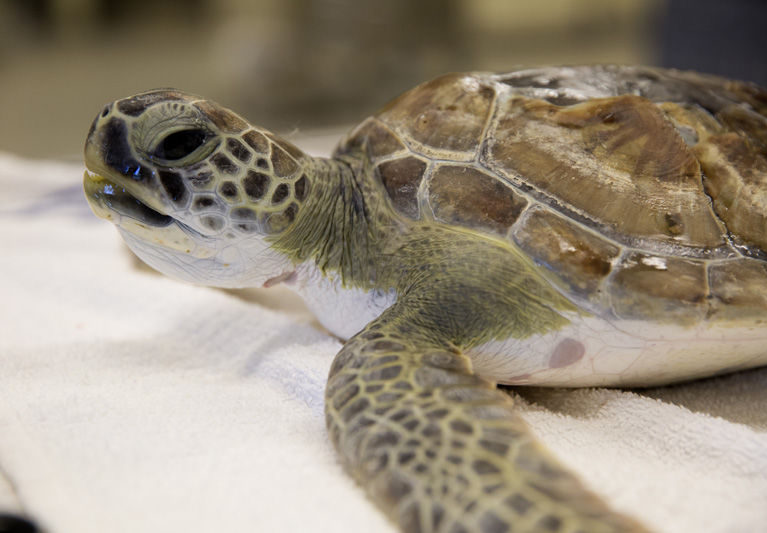
Weakened or injured sea turtles that reach our shores have a better chance of survival these days thanks to the Sea Turtle Healing Center at the Brevard Zoo, which opened in April 2014 in partnership with the Sea Turtle Preservation Society.
In recent months four turtles rehabilitated at the center have been released back into the ocean – two each at the Archie Carr National Wildlife Refuge Barrier Island Center and Round Island Beachside Park.
“These were debilitated turtles, covered in barnacles and algae,” explained Sea Turtle Program Coordinator Melanie Stadler, showing off Chad to a crowd of well-wishers at the May 17 BIC release. A juvenile green sea turtle, Chad flapped his flippers like an eager youngster ready to leave the nest. “As soon as he heard the waves he was ready to go.”
“I responded to the stranding for Mr. President,” said BIC Director Donna Lee Crawford of the other juvenile green released that day. “A fisherman found him being pounded into the shoreline at Melbourne Beach. It was on Presidents Day; that’s how he got his name.”
Those two were too small to tag in the usual fashion, and instead were given internal tracking devices, similar in size to the identification chips given to household pets. “This way, if they ever come back up on the beach, we’ll be able to scan them and see where they came from,” said Stadler.
Like most extinct or threatened species, their demise can be credited to humans, with oil spills and water pollution, plastics, including plastic bags and balloons, commercial and recreational fishing, boat propellers, poaching, coastal development and global warming among the top culprits.
Although the Brevard and Treasure Coast beaches are among some of the highest sea turtle nesting areas in the world, the closest facility equipped to treat turtles with the fibropapilloma virus (FP), which causes tumors to grow inside and outside the turtle’s body, had previously been the Gumbo Limbo Environmental Complex in Boca Raton, more than 100 miles away. Stadler, who has a master’s in marine biology from Florida Atlantic University, worked for a while at Gumbo Limbo before being hired to run the STHC.
With 12 individual tanks, the 2,400-square-foot STHC is one of only five in the state equipped to treat turtles with the contagious virus. The average stay for a debilitated turtle is four or five months, but it could be a year for a turtle with FP.
The tumors, which must be surgically removed, most often grow on soft tissue such as on the face and flippers but can also spread to internal organs. First spotted in the 1970s in the Keys, the virus is primarily found in green turtles, which spend more time in the Indian River Lagoon eating algae than the other turtles.
“We know it’s correlated to the quality of the water, caused by agricultural and wastewater runoff, including chemicals, fertilizer, pesticides and paint,” said Stadler.
Stranded turtles are generally referred to STHC through Florida Fish and Wildlife Conservation, the Sea Turtle Conservation Association and volunteers with the Sea Turtle Preservation Society.
“We’ve taken in about 21 this year so far; we took in maybe 50 last year,” said Stadler during a visit to the facility where she was treating Johnnie, from St. John’s County and Archie, rescued from the Archie Carr refuge. Stadler was assisted by Annie Buschner, an intern with the Sea Turtle Intern Program which began in April.
In addition to an old boat-strike wound, a missing flipper and FP, Archie has what they call “bubble butt syndrome” and can’t stay under the surface of the water, leaving him vulnerable to additional boat strikes.
“If the boat strike doesn’t kill them, it causes all their tissues to saturate with air throughout their body cavities,” said Stadler. “If they float like this we can’t release them back into the wild.”
Archie’s fate will depend on his FP and whether his buoyancy resolves. If he can’t be released they will work to find him a permanent home. “He’s a fun turtle; he likes attention,” said Stadler affectionately.
“Johnnie came to us as a debilitated turtle. He didn’t have any obvious injuries, but he wasn’t moving a lot. He was weak, emaciated and skinny, and covered with algae and barnacles. Usually that means he has some sort of body cavity infection,” she explained. “Johnnie also has an unusual carapace (shell). His scoots tell us this turtle is possibly a green turtle/hawksbill hybrid. We sent blood samples to FWC to see if he’s a hybrid; we are seeing more of them.”
On the mend now, Johnnie was fluttering his flippers and making it known he wasn’t happy being on the examination room treatment table.
“We only take them out of the water when we’re working with them,” she said, daubing him with a gentle antiseptic before giving him antibiotic injection. “We have some wide spectrum antibiotics that we know work for greens and then specific ones if needed.”
Before heading to the tanks to view the other patients, Stadler displayed multiple fishing hooks removed from two turtles rescued from Port Canaveral, a popular fishing jetty. She said the fisherman who hooked one of the turtles did the right thing by calling FWC instead of cutting the line.
“You will not get in trouble for hooking a turtle; it’s a very common thing. The turtle sees a fish or squid dangling from the line and goes for it.”
They also get numerous small turtles, six months to a year old, with little bits of plastic in them, but she adds, “Unfortunately a lot do not survive. The impaction is too severe and their little bodies just can’t handle it.”
Over in the tanks Toni is now doing very well, having had a very large tumor on her back flipper surgically removed six months ago.
Jaws, who got her name after being attacked by a shark, was missing most of her front flipper and had lacerations to her other flipper and her shell. “UCF brought her to us; she was found in the Indian River Lagoon. She’s doing really well; she’s right at 100 pounds.”
Isaac, also missing a front flipper, was found with a PIT tag that, when scanned, showed he had been rehabilitated at SeaWorld in Orlando in 2012. “That time he had a fishing line wrapped around his neck and flipper; this time he had some sort of infection, possibly pneumonia,” Stadler said.
Stadler said adult turtles are not common in rehab, possibly because they spend more time away from humans. “A lot of times smaller turtles live closer to shore. We are their biggest threat.”



